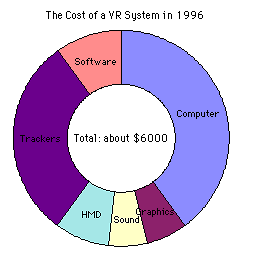
Hardware:

A VR system can be based on a personal computer. The computer controls several different sensory display devices to immerse you in a 3-dimensional virtual environment. The most common sensory displays are head-mounted displays for 3D visual and headphones for 3D audio. Since these displays need to be updated with new sensory information more than 20 times per second it often helps to have additional processing power in the form of add-on 3D graphics cards and 3D sound cards.
A VR system needs to be able to track the position and orientation of your head in order to calculate the appropriate perspectives to display. Any other body parts, such as your hands, feet, or prehensile tails, that will play an active part in the virtual environment must also be tracked. The device that does this is called (surprisingly enough) a tracking device.
Input devices make up the final category of VR hardware. In order to interact with the virtual environment you may wish to use a joystick (sometimes called a wand in VR systems), an instrumented glove, a keyboard, voice recognition, or other types of input. These devices allow you to travel through the virtual environment, manipulate objects, and perhaps even build on to the virtual world. Tracking devices are sometimes used together with input devices to add a spatial (3 dimensional) component to their operation.
In order to build virtual environments you often need auxiliary software for creating the objects that go into the virtual environment and setting their characteristics. Three-dimensional modeling software allows you to construct the geometry of the objects and specify some of their visual properties. Two-dimensional graphics software lets you manipulate textures to be applied to the objects which can often greatly enhance their visual detail. Digital sound editing software lets you mix and edit the sounds that objects make. All these software packages have other commercial uses in addition to building VR, and so there is a great variety to choose from.
The simulation software is what brings all the components together. It accepts data from the trackers and input devices, applies this information to the objects you have built, and updates the sensory displays. You use the simulation software to program how the objects behave and set the rules that the virtual world follows.